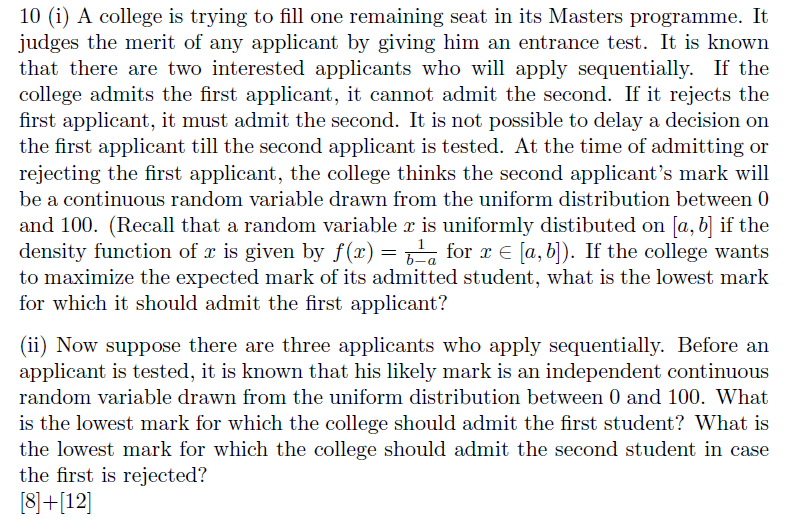ISI 2010 Q.10
|
Hi
If anyone has been able to solve 2nd part of this, please help.  What I was thinking is this E(X) > max(E(Y), E(Z)) E(X) > (E(Y) + E(Z) + |E(Y) - E(Z)|)/2 But, E(Y) = E(Z) = 50, so, E(X) > 50 But, amit sir has given answer as 62.5. |
|
Hi, this is my approach but i am unable to reach an answer.
Let L1 be the minimum marks for Student S1 to get admitted. Similarly L2 and L3. Let P(S1) = probablity that S1 is selected. E(M) is expected marks of admitted student. We want to maximize E(M) such that P(S1) + P(S2) + P(S3) = 1 E(M) = M1*P(S1) + M2*P(S2) + M3*P(S3) ---------------------------------- (1) M1 =expected marks obtained by S1. Similarly M2 and M3. Now P(S1) = (100 - L1)/100 *L2/100 * L3/100 (Similarly P(S2) and P(S3)) M1 = Integration of x.f(x)dx from L1 to 100 where f(x) = 1/100 therefore M1 = 50 - (L1)^2/200 Putting these values in equation (1) and using optimizing rules, should give us an answer but i haven't been able to do it. |
|
In reply to this post by L
The payoff for the institute is the marks of the admitted student. We need to maximise the expected payoff. Let minimum marks for admitting first student be M1 and for the 2nd be M2. So expected value of payoff is
 We can minimize this wrt to both M1 and M2 and I got m1=62.5 and m2=50 |
|
In reply to this post by L
@onionknight, agree with your logic but could not understand the equation you have used for expected marks.
E(P) should be M1*P(S1) + M2*P(S2) + M3*P(S3) right ? here, P is a discrete random variable that can take values 1 or 2 or 3 depending on which student is selected. M1 = expected marks of student S1 = integration of x/100 dx from L1 to 100(L1 = lowest marks for S1) P(S1) = probablity of S1 getting selected. S1 will get selected if S1 gets marks >=L1 and S2 gets <L2 and S3 gets <L3 therefore, P(S1) = (100-L1)/100 *L2/100 * L3/100 If I use these notations, my equation of E(P) comes out to be different from yours.. |
|
The first student's probability of getting k marks will be dk/100. Now in expected value we'll integrate kdk/100 from M1 to 100 . Suppose the first student Scores less than M1, the probability of which is M1/100. Now the second student can again score any marks k wuth a probability of dk/100. M1*kdk/10000 will be integrated from M2 to 100. The probability of rejection of both student 1 and 2 is M1/100*M2/100. Again 3 can score any value k with probability dk/100 and now M1/100*M2/100*kdk/100 will be integrated from 0 to 100. So you'll get the expected value as the sum of the three integrals shown in the image.
About your logic, for S1 to get selected, he only needs to score more than M1 regardless of what the others score so that's incorrect. Similarly for 2 to get selected marks of cost first student should be below his cut off and 2's marks should be greater than his cut off regardless of what 3 scores. Also, probability at each score k is dk/100 so you'll have to integrate for expected value. |
|
ok. I understand your point. But still, my doubt is shouldn't there be a difference between "being eligible for admission" and "actually getting admission" ?
For example, if student 1 scores more than M1, he becomes eligible for admission. But he will actually get admission when and only when he scores more than M1, and student 2 and student 3 both score less than M2 and M3 respectively. Say, after the event happens, Student 1 scores>M1 , student 2 >M2 and student 3<M3. Now, the college may or may not select student 1 (depending on how much he scores compared to student 2) Just by scoring more than his minimum marks does not guarantee admission. So should we not consider the probablity of S2 scoring less than M2 and S3 scoring less than M3, when we calculate S1's probablity of getting selected ? |
|
In reply to this post by onionknight
I never thought solution could be like that. But, there is one mistake in your solution. for a continuous random variable, P(X=k) = 0, which you are saying as dk /100, which is totally wrong.
It could also be done the way I was doing. Where I got it wrong was: it should have been E(X) > E (Max (Y,Z) rather than E(X) > Max(E(X),E(Y)) and by calculating the joint pdf of Y-Z it can be calculated. But, I think your solution is more easier. |
|
Hey onionknight, please ignore my comment. I just realised that they are taking the test sequentially.
So my point is null and void. |
|
In reply to this post by L
Oh, yep I shouldn't have put it that way. However, the expression is still correct.
|
«
Return to General Discussions
|
1 view|%1 views
| Free forum by Nabble | Edit this page |

